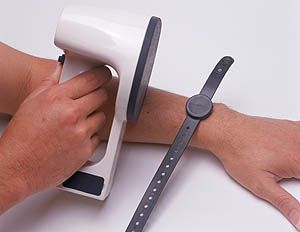|
In
the middle of 1994 thousands of refugees from Haiti
and Cuba tried to sail to the USA. The United States
Government immigration officials didn't want to simply
let them in. The refugees could apply for official refugee
status, but they couldn't just show up. The officials
picked up as many of the refugees as they could while
they were at sea, and took them to refugee camps outside
the USA to be processed. They would get refugee status
if the United States Immigration Service decided they
would be persecuted if they went home. Otherwise they
were sent back.
View
the refugee background
section to find out why there were so many Cuban and
Haitian refugees in 1994.

Thousands of refugees from Cuba
and Haiti were taken to a US naval base at Guantanamo
Bay. How would the United States keep track of who
everyone was? They used wristbands with microchips
like the ones some people put in their pets. It
doesn't hurt. The chip is in a wristband the refugees
wear on their arm (or their ankle if they're a small
child). The soldiers read the chip with a scanner
using technology called AVID. Photo: Lynne Brakeman
|
The
United States ended up with refugee camps filled with
people. They had to make a decision about each and every
one of them. They had to know who was who, and what
their stories were. To make things harder, many of the
refugees didn't speak English. The United States needed
a sophisticated information system to control the situation.
They
used a system called DMPITS (Deployable Mass Population
Identification and Tracking System).
To
start with, the military had just used colour-coded
plastic bracelets originally designed to use with prisoners
of war. These bracelets had a printed label giving some
information about the person. But some of the refugees
started changing their labels, or throwing the bracelet
away. Some pretended they were people who had already
been accepted as refugees by the United States.
The
refugees were not just a component in an information
system in the same way that an object is. They could
decide they didn't want to fit into the system the way
the United States wanted them to, and do something about
it. They could try to subvert the system. So the United
States wanted to come up with a more effective way of
controlling information about the refugees. How could
they make sure they kept track of who everyone was,
no matter what the people themselves wanted? That's
where DMPITS came in.
DMPITS
DMPITS was much harder for the refugees to subvert,
because it used much more sophisticated technology.
It used three different ways of identifying each refugee:
- microchip
each refugee had to wear
- digital
fingerprint
- video
image.
AVID:
Microchip technology
Gone were the printed labels. Instead, each refugee
had to wear a plastic wristband that had a microchip
sealed into it. This used technology called American
Veterinary Identification Devices (AVID) that was originally
developed for identifying pets. Each microchip had a
unique ID number. The soldiers had a scanner they could
use to read the number on the chip, and feed that into
a computer to bring up the person's file. But there
was no way the refugee could read it, or change it in
any way. The two ends of the wristband were riveted
together around the person's wrist so they were impossible
to take off without destroying them. (Some refugees
still cut them off or chewed through the plastic bands.)
Anyone
who wanted to know the identity of a refugee would simply
scan their wristband to read their ID number.

How can you tag a person or animal
so you can always tell its identity? One way uses
a chip worn by a person or implanted under an animal's
skin. The Powerhouse Museum in Sydney has a display
of AVID technology used to identify people and animals.
This technology was invented for pets, but it has
also been used to tag refugees.
Powerhouse Museum collection. |
Fingerprints electronically scanned
The refugees also had their fingerprint electronically
scanned into the system. This was recorded against their
ID number. It was a backup. If a refugee cut off their
wristband, they could be finger scanned again to check
who they were. Also, if anything really important was
supposed to happen with one of the refugees, the soldiers
could double check the microchip and the fingerprint
to make sure they had the right person.
Video
image
The video image meant that the United States authorities
could also check someone's identity by comparing their
face with the video image.
Refugee
data
The following data for each refugee is recorded under
an ID number:
- finger
scan
- video
image
- name
- age
- sex
- where
they were from
- medical
information
- what
stage their application was up to
- camp
number
- tent
number
- bed
number in the tent.
Once
the refugees were processed they were compelled to be
part of the system. Not only were they a number on a
database but they were also physically tagged with the
microchip wristband.

When ID chips were used to identify
people they were worn inside a wristband like this.
Powerhouse Museum collection. |
Tagging
animals and people is not a new concept. To find out
more about view the tagging
page of this site.
After
a few months the refugee crisis was over. Some of the
refugees were accepted by the United States. They were
granted asylum, and allowed to settle in the USA. The
rest were rejected by the US Department of Immigration
and Naturalization Service and were sent back to Cuba
or Haiti.
Want
to know more? Read the full
story.
What
did the refugees think about being part of a high-tech
information system, and about wearing the ID wristbands?
View the reactions to tagging
section to find out.
|